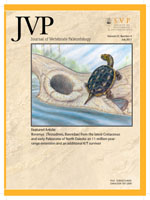Toumaï (Sahelanthropus tchadensis) is, to date, the oldest known hominine. Approximately 7 million years ago, it lived close to the northern shoreline of the paleo Lake Chad, which extended at that time 500 km north of its present location. Here, we describe a new xerine squirrel, Sabara oralacus, gen. et sp. nov., discovered near the site where Toumaï was unearthed. Study of associated fauna is essential to evaluate correctly the precise paleoenvironmental affinities of the first African hominines. The new squirrel displays a mosaic of dental and skull characters characterizing either the tribe Xerini or Protoxerini, which makes its taxonomic assignment at the tribe level difficult. From craniodental characters, we hypothesize that S. oralacus was a ground-dweller, digging burrows, probably with an ecological preference for forest to savannah environments associated with hard fruit-bearing trees.
How to translate text using browser tools
1 July 2011
A New Xerinae (Rodentia, Sciuridae) from the Late Miocene of Toros-Menalla (Chad)
Laurent Viriot,
Pablo Pelaez-Campomanes,
Patrick Vignaud,
Likius Andossa,
Hassan Taïsso MacKaye,
Michel Brunet
ACCESS THE FULL ARTICLE

Journal of Vertebrate Paleontology
Vol. 31 • No. 4
July 2011
Vol. 31 • No. 4
July 2011




